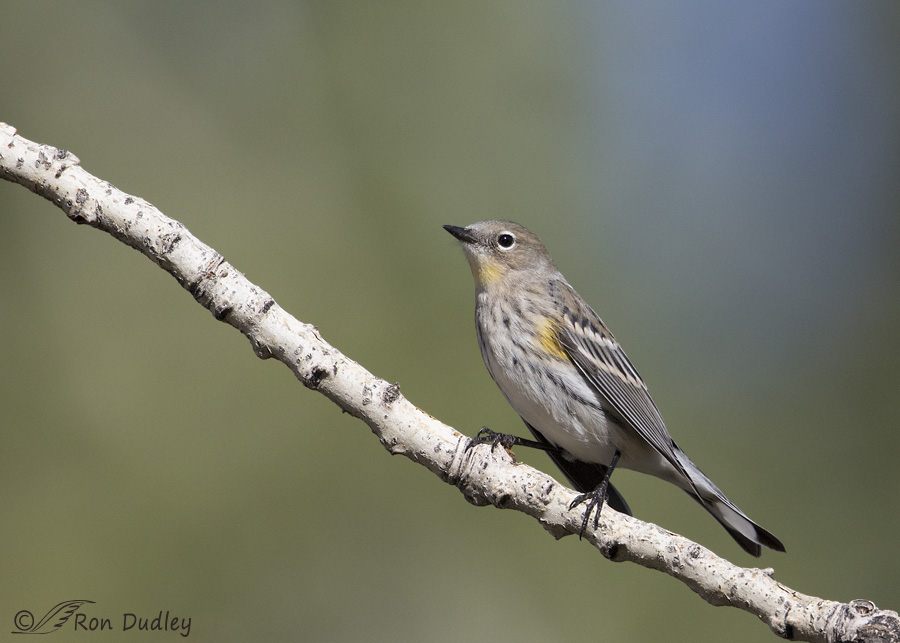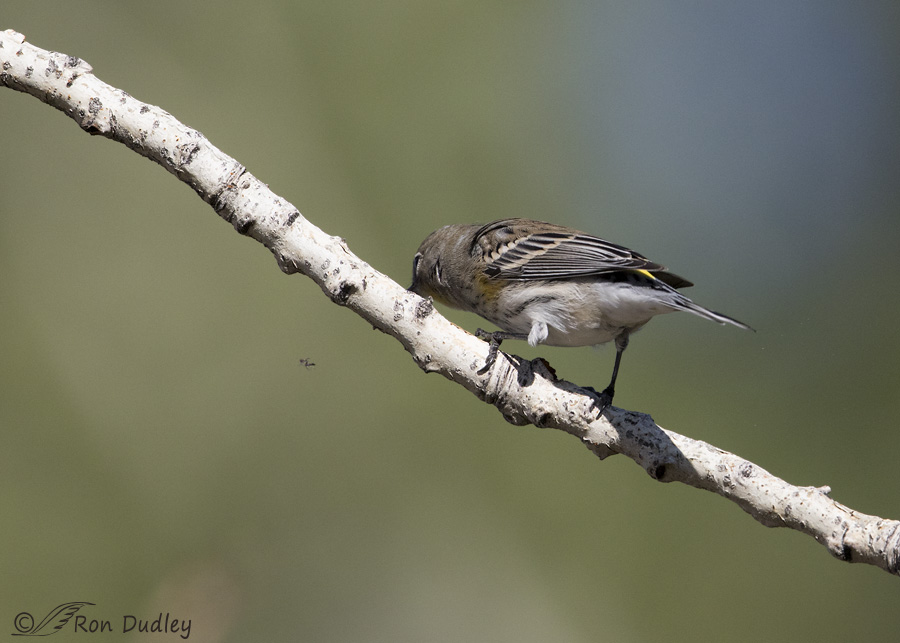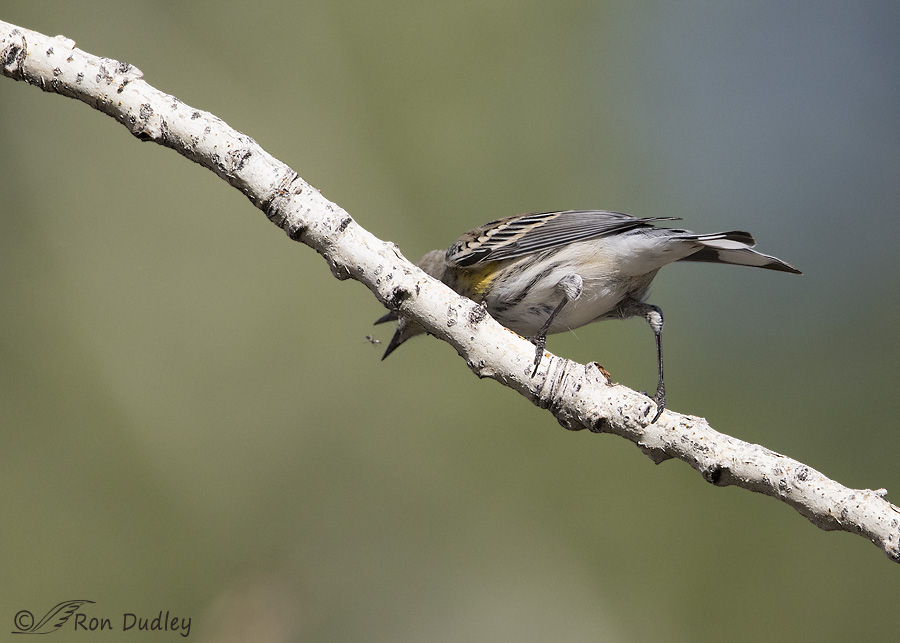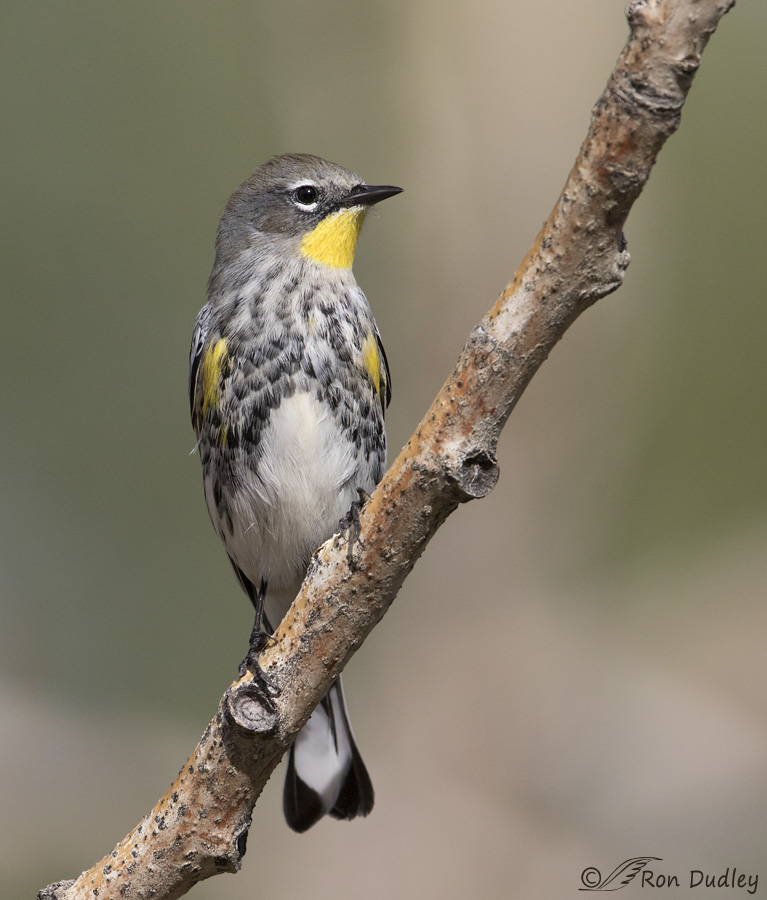Readers know I despise culling images. I also have a strong tendency to procrastinate and that unfortunate combination meant that as of yesterday I had about 7,500 recent photos to go through. The only thing that keeps me going while I’m doing it is the occasional serendipitous discovery – an image or series of images with redeeming qualities that I missed during my first pass through them.
Such was the case yesterday. As I slogged through my culling chore I stumbled across a short Yellow-rumped Warbler feeding sequence that I found interesting despite its obvious shortcomings (I wasn’t very close to the bird and there’s an aggravating branch in front of some of the action). I include that series below.

1/6400, f/6.3, ISO 800, Canon 7D Mark II, Canon EF 500mm f/4L IS II USM + EF 1.4 III Extender, not baited, set up or called in
A couple of weeks ago I spent several days photographing Yellow-rumped Warblers in a park near my home. These migrating birds were using the tree as a staging area to fly out over a pond under the tree to catch insects flying over the water. But this warbler showed me how opportunistic they can be when an unexpected flying insect makes the mistake of flying just a little too close to a hungry, perched bird.

1/6400, f/6.3, ISO 800, Canon 7D Mark II, Canon EF 500mm f/4L IS II USM + EF 1.4 III Extender, not baited, set up or called in
Here the warbler has spotted the insect and is setting up for the ambush (I actually think it was probably two mating insects but they were tiny and even when I blew the image up I couldn’t tell for sure…).

1/5000, f/6.3, ISO 800, Canon 7D Mark II, Canon EF 500mm f/4L IS II USM + EF 1.4 III Extender, not baited, set up or called in
When the “bugs” were close enough the warbler snagged them out of the air (coitus interruptus to the extreme…). It all happened so incredibly fast that I didn’t even know it had occurred until yesterday when I spotted the insects in this image with my finger already on the delete key. I find behaviors interesting enough that I’ll often keep images like these despite their flaws.
I’m fully aware that some viewers aren’t particularly interested in mediocre behavioral images so…

1/5000, f/7.1, ISO 640, Canon 7D Mark II, Canon EF 500mm f/4L IS II USM + EF 1.4 III Extender, not baited, set up or called in
I include this photo as closing eye candy to hopefully make up for it. The image appeals to me for its detail, colors, clean background (something I seldom got with these birds) and the long diagonal perch that is just sharp enough along its entire length and isn’t too bright, as many of them were.
These birds, one of the last warblers to migrate in the fall, are now in their wintering grounds in the southern US, Mexico and Central America. I enjoyed them very much while they were here.
Ron


Fascinating behavioral series, Ron. In the third shot, I like the way the angle between the branch and that crisp wing sort of mirrors the angle of the open beak.
Plus, the last “cheesecake” photo is to die for — what a beautiful photo! I can even see the small bit of yellow in the middle of the bird’s chest.
Ron,
you continually under-estimate the value of your observations and the quality of your images. Postings such as this are both interesting and important.
Keep up the good work – it is an inspiration
The near demise of this series proves my point that you should be chaperoned when you ‘re cloning…
That was supposed to be “culling”. I mean it when I say this thing hates me!!!
I don’t think Ron should be allowed to clone alone either! 😉
My eyes wouldn’t have seen those hapless insects either. And would have been grateful to see the yellow-rumped beauties.
Love behavioural shots. Even when there is tragedy (and triumph) involved for some of the participants.
Luck, shmuck.
Dedication, perserverance, practise, practise, practise. And more practise.
Thank you.
You’re right about the practice, EC. Sometimes it even pays off!
I love the frame where the luckless, twitterpate insects are flying right into the oportunistic bird’s open beak and the last, the third, is spectacular! Love the crisp feather patterns and the colors! BEAUTIFUL!!!
Thanks very much, Patty.
…and some viewers are interested in almost ALL behaviorsl images!!! There are plenty of beautiful pictutes of beautiful birds, but very few of interesting, and sometimes odd, behaviors. I look for both!
PS. I think you’re just lucky. 🙂
“There are plenty of beautiful pictutes of beautiful birds, but very few of interesting, and sometimes odd, behaviors.”
That’s my theory too, Patty – and one of the reasons I so enjoy behavioral images.
totally in agreement Patty. And together with Ron’s explanations these images become gems
OK, first, I’m gonna thwap you upside the head on the concept that your body of work is “mostly a matter of luck.” In racing, Roger Penske is credited with saying, “Luck is where preparation meets opportunity.” He’s right. You routinely gather ALL the multitude of elements together to make these shots happen, so do NOT minimize your outrageous ability as a photographer, as an educator and just an all-around super guy. I won’t allow it 🙂 Yes, I appreciate your humility. I get that. You’re doing what YOU do, but you do it at a spectacular level of excellence that so few people bother to expend the energy to attain. So there!
On to the images…again, the word spectacular comes to mind (fingers)! Both the behavioral series and the portrait teach so very much about these cool little butter-butt birds. If it were me out there, I’d be challenged just to see them in the first place (which is why I default to raptors–they’re bigger and I can see them…LOL!). But that’s why I start my day with your blog (or sometimes my afternoon, depending on what’s going on around me).
When I say thank you, that really means thank you for sharing your expertise, your knowledge and your art.
I’m with you Laura, great comment!!
Laura, I’ll assume you’re referring to my reply to Dick’s earlier comment.
Yes, there’s probably some truth in what you say but luck plays a part in it too. How could I not have been lucky to have captured something I didn’t expect and didn’t even notice when it happened? But you and Penske are correct about preparation and opportunity and Gary Player was also correct when he said “The more I practice the luckier I get”.
So thank you – for the kind words and for the reminder that more than luck is involved and I do deserve some credit… 🙂
Great behavioral sequence Ron, and yes–love the final shot–so lovely 😉 FYI: Not sure if you saw the most recent news from Cornell Laboratory of Ornithology about “butter-butts”? Here is the link: http://news.cornell.edu/stories/2016/08/butterbutt-warbler-likely-three-different-species-dna-reveals; cool stuff.
Yes, I did see that, Christine – on Cornell’s Birds of North America Online. I think I even saw somewhere that they may be divided into as many as four species…
Absolutely marvelous shots Ron!
Charlotte
Thank you, Charlotte.
I don’t care that the insect-snagging images don’t meet your requirements for being good. I like seeing the behavior, to my eyes the photos were all sharp, and got a good laugh out of your description of what happened to the “bugs”. The last image is simply spectacular. I love it when you post portraits like that.
“I love it when you post portraits like that.”
Thanks, Susan. I’d post them more often but they’re not easy to come by. Bird photography is funny like that… 🙂
Absolutely beautiful, Ron. So glad you are out there watching for all of us. Elizabeth
Thank you, Elizabeth.
Awesome shots Ron. What a great way to start my morning. Yes, the “eye candy” is the icing on the cake. Sure glad you went through them one more time.
I always to through them “one more time”, Sterling. It’s a royal pain in the rear end but it would be worse to delete interesting images out of ignorance of their existence.
A difficult species to find in the open; well done. And it’s the first photo I’ve seen of a Yellow-rumped nabbing a bug in mid-air.
Birding Magazine reports that Yellow-rumped may be split into 3-4 species.
“Birding Magazine reports that Yellow-rumped may be split into 3-4 species.”
I saw that on BNA Online, WC. Some of these changes are difficult for me to keep up with…
Great sequence, Ron. 🙂 The last photo is definitely “eye candy”
Thanks very much, Judy.
Fantastic shots – I have tried to catch Yellow-rumps eating insects or for that matter bayberries completely unsuccessfully!!
I am ALWAYS amazed at your ability and patience in providing these kind of shots. WOW! Branch isn’t a bother to me!
Last 2 weeks we have been seeing a few Yellow-rumps, Palm and Yellow Warbler. They just don’t stay in one place for long! Arrive today gone tomorrow, then another flight comes in.
“I am ALWAYS amazed at your ability and patience in providing these kind of shots”
Thanks Dick. But to be perfectly honest it was mostly a matter of luck in this case. About the only thing I’ll take credit for is my tendency to shoot at high shutter speeds (a little too high here) so that these very fast behavioral images are sharp.